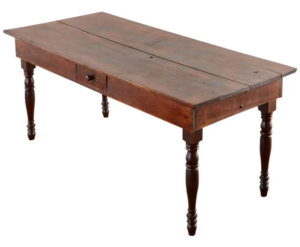QUESTION OF THE WEEK: June 3, 2021.
Do you have a question and want to possibly be featured? E-mail me here and I’ll do my best to answer. Be sure to include QUESTION OF THE WEEK as the subject line.  Keep in mind, my answers here are mostly general and should not take the place of a more in-depth and precise valuation.
Keep in mind, my answers here are mostly general and should not take the place of a more in-depth and precise valuation.
QUESTION: “How can you tell a good antique farm table from a fake?” – Ted from River Forest, Illinois.
ANSWER: I like to avoid the word “fake” to describe vintage or antique items unless there are overt, nefarious signs a piece is knowingly presented as something it’s not. This is rarer in my field and area than some might think and usually easily determined by a quick look under the hood.
These are the things I look for when trying to determine the age of a table:
- The style. Styles come and go and then come back again. If you can determine the style you can likely get in the ballpark of when it was designed.
- Construction. Was it carved using machine tools? Is there applied wood? How is it held together? Bolts? Wood nails? Flat screws? Philips screws? Hand carved tends to be older. Bolts, wood and flat screws tend to be older. Applied wood designs are more stylistic (see above) but were more popular in some eras than others.
- Materials. Is it solid wood? If so, can you determine the type of wood? I tend to cast a narrow net initially and presume most items originate in the US (where I’m located) unless told by the client or proven otherwise often by the materials used and sometimes the construction. If I can’t determine the materials are North American in origin, then I may expand my search.
- Provenance. This requires talking to the owner. Sometimes they may know a lot about the piece and offer a lot of information that can be verified via the other conditions noted above. But sometimes the owner doesn’t know a lot. Never hurts to ask.
As far as determining “Good” that comes down to condition and “farm tables” tend to take a beating. Does it wobble? Is it pretty beat up? If not, perhaps it’s been refurbished and improved upon and may even employ some modern construction techniques. I’m fine with that. It’s practical, it extends the life of an antique and it doesn’t detract from its aesthetics when done well. Some may view this as cheating, but maintaining antique furniture is necessary. And not all antique furniture was made by master carpenters.
As for “fakes,” I prefer to call them reproductions. And I’m fine with them as long as they are presented as such and not presented as 100-year-old French farm tables.
I worked for a very wealthy client recently with a beautiful antique English dining room set. At least that’s what I thought. A closer inspection showed it was clearly a modern reproduction, dating from the early 2000s. It was still highly valuable, but proof that reproductions aren’t inherently cheap.
Have more questions? E-mail me at grantmiller@grantmillerappraisals.com. In Illinois and looking for an antiques appraisal? Call or text me at 813-240-4586 (Chicago and elsewhere).